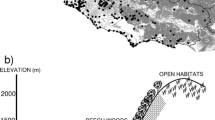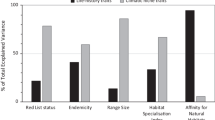Abstract
We investigated the influence of body size on rarity patterns at a regional scale using the tenebrionid beetles of Latium (Central Italy). For this we calculated geographical range size (no. of 10 km square cells), habitat breadth (no. of phytoclimatic units), and abundance (no. of sampled individuals) using a large database containing 3,561 georeferenced records for 84 native species. For each species, we used total body length to correct rarity measures for body size. Then we calculated vulnerability (Kattan) indices using both corrected and uncorrected rarity scores. Finally we used species range trends (expanded vs. contracted) as a measure of actual species decline. We found that range trends were correlated with vulnerability index independently from body size correction, the species with the highest vulnerability being those that experienced the strongest range contraction for both corrected and uncorrected measures. Also, we found that correcting for body size may be problematic because of the weak correlations between body size and geographical and ecological rarity (notably, abundance was not correlated). These findings indicate that correcting rarity for body size is not only theoretically questionable, but also practically difficult and possibly useless for conservation purposes.




Similar content being viewed by others
References
Aliquò V, Rastelli M, Rastelli S, Soldati F (2006) Coleotteri Tenebrionidi d’Italia. CD-ROM Museo Civico di Storia Naturale di Carmagnola, Carmagnola
Arita HT, Robinson JG, Redford KH (1990) Rarity in Neotropical forest mammals and its ecological correlates. Conserv Biol 4:181–192
Blackburn TM, Gaston KJ (1994) Animal body size distributions: patterns, mechanisms and implications. Trends Ecol Evol 9:471–474
Blackburn TM, Harvey PH, Pagel MD (1990) Species number, population density and body size relationships in natural communities. J Anim Ecol 59:335–345
Blackburn TM, Brown VK, Doube BM, Greenwood JJD, Lawton JH, Stork NE (1993) The relationship between abundance and body size in natural animal assemblages. J Anim Ecol 62:519–528
Blasi C (1994) Carta del fitoclima del Lazio. Regione Lazio and Università di Roma “La Sapienza”, Rome
Bowman J (2003) Is dispersal distance of birds proportional to territory size? Can J Zool 81:195–202
Bowman J, Jaeger JAG, Fahrig L (2002) Dispersal distance of mammals is proportional to home range size. Ecology 83:2049–2055
Brändle M, Öhlschläger S, Brandl R (2002) Range sizes in butterflies: correlation across scales. Evol Ecol Res 4:993–1004
Brose U, Jonsson T, Berlow EL, Warren P, Banasek-Richter C, Bersier L-F, Blanchard JL, Brey T, Carpenter SR, Blandenier MFC, Cushing L, Dawah HA, Dell T, Edwards F, Harper-Smith S, Jacob U, Ledger ME, Martinez ND, Memmott J, Mintenbeck K, Pinnegar JK, Rall BC, Rayner TS, Reuman DC, Ruess R, Ulrich W, Williams RJ, Woodward G, Cohen JE (2006) Consumer-resource body-size relationships in natural food webs. Ecology 87:2411–2417
Brown JH (1995) Macroecology. University of Chicago Press, Chicago
Brown JH, Maurer BH (1989) Macroecology: the division of food and space among species on continents. Science 243:1145–1150
Brown JH, Stevens GC, Dawn MK (1996) The geographic range: size, shape, boundaries, and internal structure. Annu Rev Ecol Syst 27:597–623
Brown JH, Gillooly JF, Allen AP, Savage VM, West GB (2004) Toward a metabolic theory of ecology. Ecology 85:1771–1789
Cardoso P, Erwin TL, Borges PAV, New TR (2011) The seven impediments in invertebrate conservation and how to overcome them. Biol Conserv 144:2647–2655
Cederna C (1980) Nostra Italia del miracolo, Longanesi, Milano
Clauset A, Erwin DH (2008) The evolution and distribution of species body size. Science 321:399–401
Cox RL, Underwood EC (2011) The importance of conserving biodiversity outside of protected areas in Mediterranean ecosystems. PLoS ONE 6:e14508
Crafts N, Toniolo G (1996) Economic growth in Europe since 1945. Cambridge University Press, Cambridge
Davies KF, Margules CR, Lawrence JF (2000) Which traits of species predict population declines in experimental forest fragments? Ecology 81:1450–1461
Dobson FS, Yu J (1993) Rarity in Neotropical forest mammals revisited. Conserv Biol 7:586–591
Etienne RS, Olff H (2004) How dispersal limitation shapes species-body size distributions in local communities. Am Nat 163:69–83
Fattorini S (2008a) A multidimensional characterization of rarity applied to the Aegean tenebrionid beetles (Coleoptera Tenebrionidae). J Insect Conserv 12:251–263
Fattorini S (2008b) Ecology and conservation of tenebrionid beetles in Mediterranean coastal areas. In: Fattorini S (ed) Insect ecology and conservation. Research Signpost, Trivandrum, pp 165–297
Fattorini S (2013) Relations between species rarity, vulnerability, and range contraction for a beetle group in a densely populated region in the Mediterranean biodiversity hotspot. Conserv Biol (in press)
Fattorini S, Cardoso P, Rigal F, Borges PVA (2012) Use of arthropod rarity for area prioritisation: insights from the Azorean Islands. PLoS ONE 7:e33995
Fattorini S, Sciotti A, Tratzi P, Di Giulio A (2013) Species distribution, ecology, abundance, body size and phylogeny originate interrelated rarity patterns at regional scale. J Zool Syst Evol Res. doi:10.1111/jzs.12026
Gabriel R, Homem N, Couto A, Calvo Aranda S, Borges PAV (2011) Azorean bryophytes: a preliminary review of rarity patterns. Açoreana Suplemento 7:149–206
Gaston KJ (1994) Rarity. Chapman & Hall, London
Gaston KJ, Blackburn TM (1996) Conservation implications of geographic range size-body size relationships. Conserv Biol 10:638–646
Gaston KJ, Fuller RA (2009) The sizes of species geographic ranges. J Appl Ecol 46:1–9
Gaston KJ, Lawton JH (1988) Patterns in the distribution and abundance of insect populations. Nature 331:709–711
Gaston KJ, Lawton JH (1990) Effects of scale and habitat on the relationship between species local abundance and large scale distribution. Oikos 58:329–335
Ginsborg P (2003) A history of contemporary Italy. Palgrave Macmillan, New York
Gotelli NJ, Entsminger GL (2001) EcoSim: null models software for ecology. Version 7.0. Acquired Intelligence Inc. & Kesey-Bear. http://homepages.together.net/~gentsmin/ecosim.htm
Guidoni E, Petrucci G, Mazzanti R, Mongini GM, Palagiano C, et al (1985) Guide d’Italia. Lazio. Fabbri, Milano
Hanski I (1978) Some comments on the measurement of niche metrics. Ecology 59:168–174
Hartley S, Kunin WE (2003) Scale dependency of rarity, extinction risk, and conservation priority. Conserv Biol 17:1559–1570
Hernández Fernández M, Vrba ES (2005) Body size, biomic specialization and range size of African large mammals. J Biogeogr 32:1243–1256
Isaac JL, Vanderwal J, Johnson CN, Williams SE (2009) Resistance and resilience: quantifying relative extinction risk in a diverse assemblage of Australian tropical rainforest vertebrates. Divers Distrib 15:280–288
IUCN (2001) IUCN red list categories and criteria: Version 31 IUCN Species Survival Commission. IUCN, Gland, Switzerland, and Cambridge, UK
IUCN (2003) Guidelines for application of IUCN Red List Criteria at regional levels: Version 3.0. IUCN Species Survival Commission, IUCN, Gland, Switzerland and Cambridge, UK
Kattan G (1992) Rarity and vulnerability: the birds of the Cordillera Central of Colombia. Conserv Biol 6:64–70
Kozłowski J, Gawelczyk AT (2002) Why are species’ body size distributions usually skewed to the right? Funct Ecol 16:419–432
Loder N, Gaston KJ, Warren PH, Arnold HR (1998) Body size and feeding specificity: macrolepidoptera in Britain. Biol J Linn Soc 63:121–139
Lomolino MV, Riddle BR, Whittaker RJ, Brown JH (2010) Biogeography, 4th edn. Sinauer Associates, Sunderland
Maes D, Vanreusel W, Jacobs I, Berwaerts K, Van Dyck Hans H (2012) Applying IUCN red list criteria at a small regional level: a test case with butterflies in Flanders (north Belgium). Biol Conserv 145:258–266
Manne LL, Pimm SL (2001) Beyond eight forms of rarity: which species are threatened and which will be next? Anim Conserv 4:221–229
Morse DR, Lawton JH, Dodson MM, Williamson MH et al (1985) Fractal dimension of vegetation and the distribution of arthropod body lengths. Nature 314:731–733
Morse DR, Stork NE, Lawton JH (1988) Species number, species abundance and body length relationships of arboreal beetles in Bornean lowland rain forest trees. Ecol Entomol 13:25–37
Murray BR, Hose GC (2005) The interspecific range size-body size relationship in Australian frogs. Global Ecol Biogeogr 14:339–345
Myers N, Mittermeier RA, Mittermeier CG, da Fonseca GAB, Kent J (2000) Biodiversity hotspots for conservation priorities. Nature 403:853–858
Novotný V, Kindlmann P (1996) Distribution of body sizes in arthropod taxa and communities. Oikos 75:75–82
Olalla-Tarraga MA, Rodriguez MA (2007) Energy and interspecific body size patterns of amphibian faunas in Europe and North America: anurans follow Bergmann’s rule, urodeles its converse. Global Ecol Biogeogr 16:606–617
Pullin AS (2002) Conservation biology. Cambridge University Press, Cambridge
Pyron M (1999) Relationships between geographical range size, body size, local abundance, and habitat breadth in North American suckers and sunfishes. J Biogeogr 26:549–558
Rabinowitz DS (1981) Seven forms of rarity. In: Synge H (ed) The biological aspects of rare plant conservation. Wiley, Chichester, pp 205–217
Reemer M, van Helsdingen PJ, Kleukers RMJC (eds) (2003) Changes in ranges: invertebrates on the move. Proceedings of the 13th International Colloquium of the European Invertebrate Survey, Leiden, 2–5 Sep 2001. European Invertebrate Survey, Leiden
Samways MJ, McGeoch M, New TR (2010) Insect conservation. A handbook of approaches and methods. Oxford University Press, Oxford
Strayer DL (1999) Statistical power of presence–absence data to detect population declines. Conserv Biol 13:1034–1038
Strona G, Galli P, Montano S, Seveso D, Fattorini S (2012) Global-scale relationships between colonization ability and range size in marine and freshwater fish. PLoS ONE 11:e49465
Acknowledgments
E. Maurizi, A. Sciotti, and P. Tratzi were instrumental in making this research feasible through digitizing and georeferencing many records. R. Lo Monaco helped us to collect body size measures. We are grateful to two anonymous referees for their constructive comments.
Author information
Authors and Affiliations
Corresponding author
Electronic supplementary material
Below is the link to the electronic supplementary material.
Rights and permissions
About this article
Cite this article
Fattorini, S., Di Giulio, A. Should we correct rarity measures for body size to evaluate arthropod vulnerability? Insights from Mediterranean tenebrionid beetles. Biodivers Conserv 22, 2805–2819 (2013). https://doi.org/10.1007/s10531-013-0556-7
Received:
Accepted:
Published:
Issue Date:
DOI: https://doi.org/10.1007/s10531-013-0556-7




